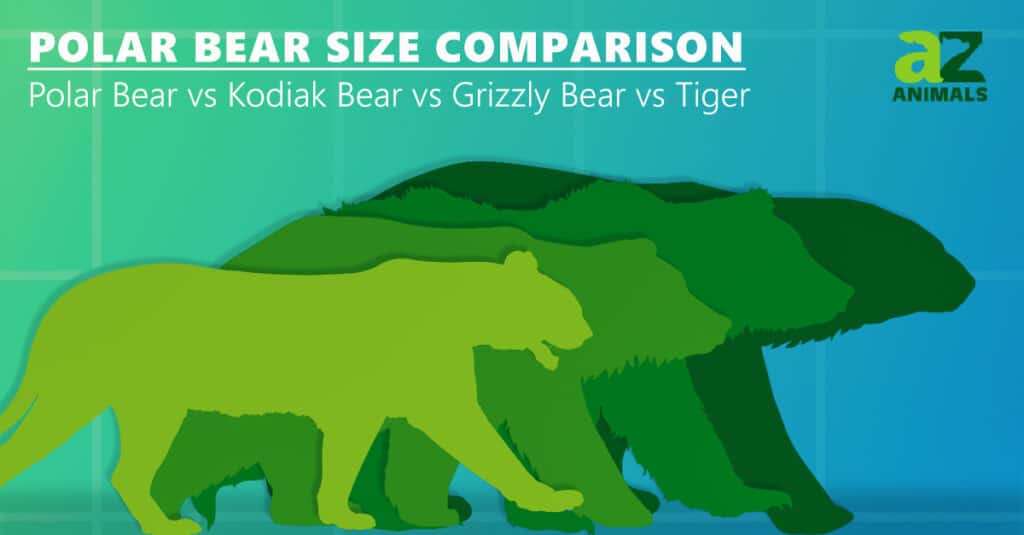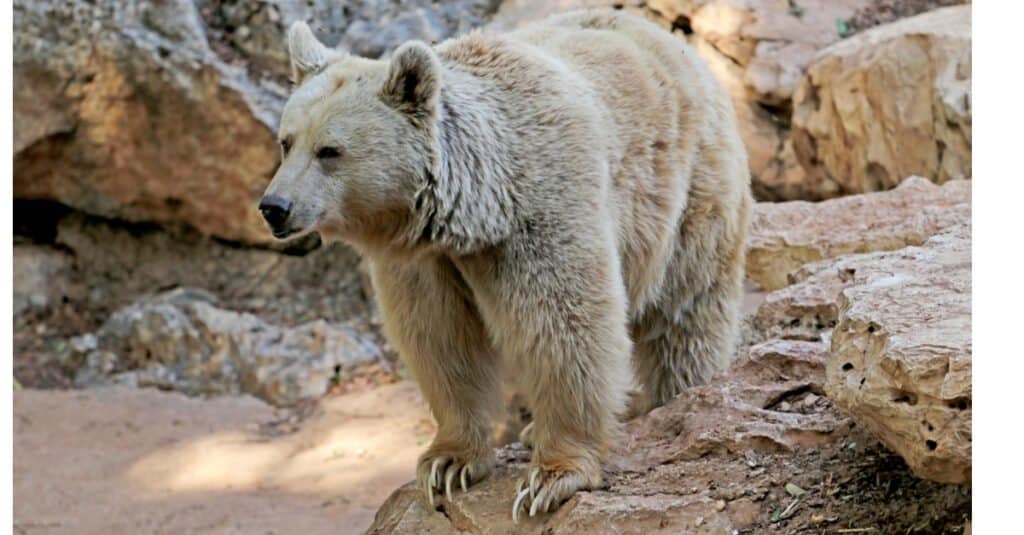
Though it was a close call to decide, scientists have declared polar bears the largest bear in the entire world. However, when it comes to a polar bear size comparison, how do polar bears measure up to some of the other top land predators?
Judging between two numbers can make it difficult to get a grasp of just how big polar bears are. After all, few rulers can show the true size of a 5-foot withers (that’s the point of an animal’s shoulders and is how many animals’ heights are measured).
This complete polar bear guide will do more than teach you just how large polar bears are compared to Kodiak bears, grizzly bears, and tigers – it’ll also do so in a way that makes it easy to grasp the full extent of what makes the polar bear the largest bear in the world.
How Big are Polar Bears?

A polar bear’s paw can be up to 12 inches in diameter!
©Louise Ekeblad/Shutterstock.com
Polar bears are the largest bear in the world. They also happen to be the largest modern land predator.
Thanks to their protein-rich diet filled with seals, fish, and other common artic prey, polar bears are able to grow into large, muscular frames that are beneficial for both hunting and staying warm in well below freezing temperatures. Despite the full and fluffy appearance their fur gives them, however, polar bears are actually quite lean.
The largest polar bear ever recorded was a 12-foot Alaskan polar bear. That’s right, standing on its hind legs, this massive bear was the same height as an African elephant. Given this tall frame, you would expect such a large animal to weigh thousands of pounds. While this isn’t completely false, it did only weigh around 2,200 pounds – and that’s uncommon!
On average, polar bears won’t get much taller on their hind legs than 10 feet. On all fours, this measurement drops to 5 feet at the shoulders. This is slightly shorter than the average adult female in the United States.
However, despite their height, the average polar bear doesn’t weigh close to 2,000 pounds. Usually, males only weigh slightly more than 1,500 at most, and females won’t usually weigh more than 600 pounds.
Still, that doesn’t stop them from being the largest type of bear!
Kodiak Bear Size

Kodiak brown bears are the largest type of
brown bear
!
©Steve Hillebrand, USFWS / Free to use CC0, Pixnio – License
The Kodiak bear is the largest brown bear, and, when it comes to the title of the largest type of bear, a polar bear size comparison will show that the Kodiak bear isn’t far off.
When the average Kodiak bear is lumbering around the Alaskan wilderness on all fours, you can expect its shoulder height to be close to 4.9 feet tall, only mere inches off of the polar bear. And when it comes to standing upright, the Kodiak bear is only 0.2 feet smaller than the polar bear. That’s around the same length as a bar of soap, and it’s the only thing keeping the Kodiak bear from stealing the polar bear’s throne.
When it comes to weight, the Kodiak bear balances the scale with the polar bear thanks to its average maximum weight of 1,500 pounds. However, the largest Kodiak bear ever lived in a zoo and was estimated to weigh nearly 2,400 pounds when he died in 1987 – which would be more than the largest polar bear ever if true! The “official” record for largest Kodiak bear stands at 1,656 pounds and was a Kodiak bear captured in the wild!
The Kodiak bear’s claws are also nearly twice as long as the polar bear’s, though the latter is known for the sharpness of its claws rather than their size.
Grizzley Bear Size

Adult grizzly bears can weigh over 1000 pounds!
©Yurii 1111/Shutterstock.com
Like the Kodiak bear, the grizzly bear is another type of brown bear, though they’re slightly smaller. This means that, compared to the polar bear, there’s a notable size difference, one that may not be as apparent with larger types of brown bears.
On their hind legs, grizzly bears usually reach an average maximum of six and a half feet. Many adult humans can also reach this same height. Their shoulder height is only slightly more than 3 feet, which is around the same height as the average 3-year-old in the United States. It’s also around the same shoulder height for many common large dog species, such as Great Danes.
Despite being smaller in height than the polar bear by several feet, the grizzly bear can reach weights of up to 1,200 pounds!
Grizzly bears have some of the longest claws of different bear species due to their dependency on climbing trees, an activity you’d almost never catch a polar bear doing.
Tiger Vs. Polar Bear Size Comparison

Tigers are the largest species of big cat!
©w1snu.com/Shutterstock.com
Tigers are the polar bears of the big cat world. With a shoulder height of up to 42 inches and a total body length of nearly 7 feet, tigers are the largest species of wild cat that you’ll encounter in this era.
So how do they size up to polar bears?
Surprisingly, not well.
Despite being the biggest of the big when it comes to cats, when it comes to shoulder height, tigers are nearly half the size of polar bears. They also weigh only a fraction of adult male polar bears, with the largest of tigers only growing to weigh around 660 pounds.
Even the largest tiger ever, which beat the average polar bear height by 11 inches, only weighed 932 pounds That’s still nearly 600 pounds less than the average maximum weight of polar bears, and over 1,200 less than the largest polar bear ever recorded!
The photo featured at the top of this post is © Vaclav Sebek/Shutterstock.com
Thank you for reading! Have some feedback for us? Contact the AZ Animals editorial team.






